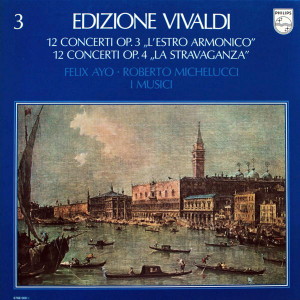 |
|
5 LP's
- 6768 009 - (c) 1978
|
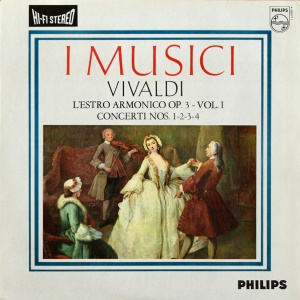 |
| 1 LP -
835 162 - (p) 1963 |
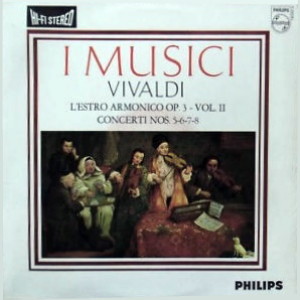 |
| 1 LP -
835 162 - (p) 1963 |
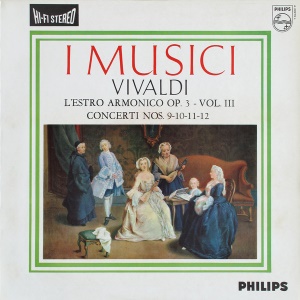 |
| 1 LP -
835 163 - (p) 1963 |
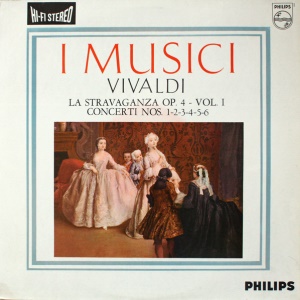 |
| 1 LP -
835 209 - (p) 1963 |
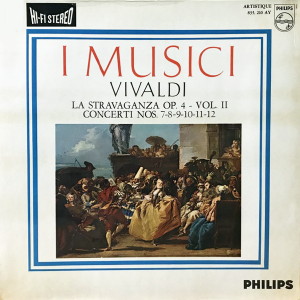 |
| 1 LP -
835 210 - (p) 1963 |
|
EDIZIONE
VIVALDI - Vol. 3
|
|
|
|
|
|
|
|
| Antonio
Vivaldi (1678-1741) |
|
|
|
|
|
|
|
| Long Playing
1 |
|
35' 32" |
|
12 Concerti op. 3
für eine, zwei oder vier Violinen,
Streciher und Continuo "L'Estro
armonico"
|
|
|
|
| -
Concerto Nr. 1 D-dur mit vier
oggligaten Violinen, RV/R. 549 (P.
146) |
8' 49"
|
|
|
-
Concerto Nr. 2 g-moll mit zwei
obligaten Violinen und obligatem
Violoncello, RV/R. 578 (P. 326)
|
11' 14" |
|
|
|
|
|
|
| -
Concerto Nr. 3 G-dur mit obligaer
Violine, RV/R. 310 (P. 96) |
7' 09" |
|
|
| -
Concerto Nr. 4 e-moll mit vier
obligaten Violinen, RV/R. 550 (P.
97) |
8' 20" |
|
|
Long Playing
2
|
|
40' 24" |
|
| -
Concerto Nr. 5 A-dur mit zwei
obligaten Violinen, RV/R. 519 (P.
212) |
8' 11" |
|
|
| -
Concerto Nr. 6 a-moll mit obligater
Violine, RV/R. 356 (P. 1) |
8' 40" |
|
|
|
|
|
|
| -
Concerto Nr. 7 F-dur mit vier
obligaten Violinen und obligatem
Violoncello, RV/R. 567 (P. 249) |
11' 42" |
|
|
| - Concerto
Nr. 8 a-moll mit zwei
obligaten Violinen, RV/R.
522 (P. 2) |
11' 51" |
|
|
| Long Playing
3 |
|
41' 18" |
|
| -
Concerto Nr. 9 h-moll mit obligater
Violine, RV/R. 230 (P. 147) |
8' 22" |
|
|
| -
Concerto Nr. 10 h-moll mit vier
obligaten Violinen und obligatem
Violoncello, RV/R. 580 (P. 148) |
10' 28" |
|
|
|
|
|
|
| - Concerto
Nr. 11 d-moll mit zwei
obligaten Violinen und
obligatem Violoncello, RV/R.
565 (P. 250)
|
11' 24"
|
|
|
| -
Concerto Nr. 12 E-dur
mit obligater
Violine, RV/R. 265
(P. 240) |
11' 04" |
|
|
| Long Playing
4 |
|
53' 20" |
|
12
Concerti op. 4 für Violine,
Streicher und Contibuo (Orgel) "La
Stravaganza"
|
|
|
|
| -
Concerto Nr. 1 B-dur,
RV/R. 383a (P. 327) |
8' 54" |
|
|
| -
Concerto Nr. 2
e-moll, RV/R. 279
(P. 98) |
10' 38" |
|
|
| -
Concerto Nr. 3
G-dur, RV/R. 301 (P.
99) |
9' 10" |
|
|
|
|
|
|
| -
Concerto Nr. 4
a-moll, RV/R. 357
(P. 3) |
9' 20" |
|
|
| -
Concerto Nr. 5 A-dur,
RV/R. 347 (P. 213) |
10' 20" |
|
|
| -
Concerto Nr. 6
g-moll, RV/R. 316a
(P. 328) |
9' 58" |
|
|
| Long Playing
5 |
|
52' 17" |
|
| -
Concerto Nr. 7 C-dur
mit zwei Violinen
und obligatem
Violoncello, RV/R. 185
(P. 4) |
9' 04" |
|
|
| -
Concerto Nr. 8 d-moll
(Continuo: Cembalo),
RV/R. 249 (P. 253) |
7' 31" |
|
|
| -
Concerto Nr. 9 F-dur,
RV/R. 284 (P. 251) |
8' 17" |
|
|
|
|
|
|
| -
Concerto Nr. 10
c-moll, RV/R. 196
(P. 413) |
8' 50" |
|
|
| -
Concerto Nr. 11
D-dur, RV/R. 204 (P.
100) |
7' 15" |
|
|
| -
Concerto Nr. 12
G-dur, RV/R. 298 (P.
100) |
11' 20" |
|
|
|
|
|
|
Op.
3 "L'Estro armonico"
|
Op.
4 "La Stravaganza" |
|
Roberto Michelucci, Violine
(Nr. 1-12)
|
Felix Ayo, Violine
(Nr. 1-12)
|
|
Walter Gallozzi, Violine
(Nr. 1,4,7,10)
|
Walter Gallozzi,
Violine (Nr. 7) |
|
| Anna Maria
Cotogni, Violine (Nr.
1,4,7,8,10,11) |
Enzo Altobelli,
obligates Violoncello |
|
| Luciano Vicari,
Violine (Nr. 1,4,7,10) |
I MUSICI |
|
| Italo
Colandrea, Violine (Nr.
2,5) |
Maria Teresa
Garatti, Orgel und Cembalo |
|
| Enzo
Altobelli, Violoncello
(Nr. 2,7,10,11) |
|
|
| I MUSICI |
|
|
| Maria Teresa
Garatti, Cembalo |
|
|
|
|
|
|
Luogo
e data di registrazione |
|
La
Chaux-de-Fonds (Svizzera) -
settembre 1962 (op. 3, nr.
1,3,4,6,7,9,10,12)
Schweningen (Olanda) - giugno 1962
(op. 3, nr. 2,5,8,11)
La Chaux-de-Fonds (Svizzera) -
luglio 1963 (op. 4)
|
|
|
Registrazione: live /
studio |
|
studio |
|
|
Producer / Engineer |
|
- |
|
|
Prima Edizione
originale LP |
|
Philips
- 835 162 - (1 LP) - durata 35'
32" - (p) 1963 - Analogico - (op.
3, vol. 1/3)
Philips - 835 163 - (1 LP) -
durata 40' 24" - (p) 1963 -
Analogico - (op. 3, vol. 2/3)
Philips - 835 164 - (1 LP) -
durata 41' 18" - (p) 1963 -
Analogico - (op. 3, vol. 3/3)
Philips - 835 209 - (1 LP) -
durata 53' 20" - (p) 1963 -
Analogico - (op. 4, vol. 1/2
Philips - 835 210 - (1 LP) -
durata 52' 17" - (p) 1963 -
Analogico - (op. 4, vol. 2/2)
|
|
|
Note |
|
-
|
|
|
|
|
|
|
"L'ESTRO
ARMONICO,"
OP. 3
Vivaldi’s
Op. 3 was published about
1712 by Estienne Roger of
Amsterdam, and bears the
title ”L’Estro
armonico” (approximately
translated: "Harmonic
inspiration"). There are
12 concertos in the opus,
which was the first of his
concerto collections to be
published. The individual
concertos can be
classified according to
setting: four are written
for solo violin, four for
two violins, and four for
four violins, all with the
accompaniment of strings
and harpsichord. The
majority have three
movements; sometimes a
slow introduction is added
as in the second concerto,
or the piece is opened by
an animated “Perfidia” as
in the eleventh concerto.
The sequence of the
movements in the fourth
concerto,
slow-quick-slow-quick, is
reminiscent of the church
sonata. For the rest,
Vivaldi prefers the North
Italian concerto type,
primarily established by
Giuseppe Torelli, and
characterised by the
differentiation of
thematic material between
solo and tutti
parts. These concertos are
therefore not constructed
as, for example, those of
Pasquini and Corelli, on
the principle of an
identical content for soli
and tutti, but
develop from varied
thematic material which is
suited to the different
abilities of soloists and
ripienists. Thus the tutti
ritornelli are
usually built on broad,
weighty themes, while the
solo parts have virtuoso
passages and richly
embellished fioriture.
Six of these concertos
were later arranged for
organ or clavier by J.
S. Bach: No. 3 (transposed
to F major), No. 7, No.
8, No.
10 for four claviers and
transposed to A minor, No.
11,
and No. 12, transposed to
C major.
A comparative examination
of these concertos in Op.
3 compels one to marvel at
the richness and diversity
of Vivaldi’s invention,
his sense of form and
sonority, and at his
command of instrumental
writing. They reveal
Vivaldi the great
craftsman, and also the
tireless experimenter. In
this respect the title
”L’Estro armonico” for Op.
3 is entirely appropriate.
The first concerto in D is
for four violins obbligati
and one solo cello. The
opening movement already
makes it clear that
Vivaldi is not slavishly
copying an adopted form,
but freely and ingeniously
modifying the formal
principle. First and
second solo violins begin
with an imitative theme,
which does not appear
again in this form; its
quaver figure is later
taken over for the most
part by the tutti,
while the solo violins and
cello retain the
semiquaver figure. In
the middle movement a
descending theme in octave
unison forms the thrice
repeated ritornello,
while the solo
violins play figurations
over an accompaniment from
the violas. The work ends
with a lively, extended
movement in 9/8 time. Here
for once soli and
tutti have
identical thematic
material, which in the
long solo sections
is freely extended in
figurations and passage
work.
The second concerto in C
minor for two violins and
cello obbligati is
prefaced by a slow
introduction, which by its
mood and solemnity,
suggests that the piece
was written for the
church. The tutti
theme of the subsequent Allegro
is based on a semiquaver
run, spanning the octave,
which becomes increasingly
agitated. The solo violin
passages also have running
semiquaver figures, which
are contrasted with the tutti
motive. In the Larghetto,
chords in dotted rhythm,
now loud, now soft, form
the ritornello. In
between times, a cantilena,
also in dotted rhythm, is
interposed in the tutti,
and echoed by the solo
instruments. The final Allegro
is in 12/8 time, and in
the manner of a gigue. A
brief chromatically
ascending motive offers
some surprising harmony.
In the third work, a solo
concerto in G, the solo
violin takes on special
prominence in the second
and third movement. After
a bar by bar exchange
between solo and
tutti, the cantilena
becomes more and more
extended in the middle
movement. In the last
movement the lengthy solo
passages are accompanied
by the higher strings - a
device also used by Mozart
- or by tutti
chords. Along with the
requisite modulation to B
minor, the first movement
is a particularly fine
example of the standard
concerto form.
Unlike the others, the
fourth concerto in E minor
for four violins has four
movements. A dotted motive
melodically differentiated
between soli and tutti,
gives unity to the first Andante.
In the following Allegro,
the solo violins usually
play singly or at most in
pairs. The mellow
atmosphere of the opening
movement is here relieved
by an opulent virtuosity.
A brief Adagio -
only a few bars long -
provides a breathing space
before the brisk attack of
the closing Allegro,
with its continuous
animated impetus. The
simplest harmonic
relationships, constant
interplay of soli
and tutti and the
transparent quality of the
writing lend the movement
the elegance and polish
which we always admire
afresh in Vivaldi.
In
the fifth concerto in A
for two violins obbligati,
the bold unison opening,
extending over nine bars,
bears the true Venetian
stamp: Benedetto Marcello
once said that a unison
played majestically and
with fire by massed
strings
is always
effective. This unison
beginning appears as a ritornello
three times in the course
of the first movement. In
between come finely
chiselled solo
passages for the violins,
sometimes without bass
support, sometimes
accompanied by delicate
quaver chords. The middle
movement is entirely
reserved for the first solo
violin, which soars above
soft quaver chords from
the upper strings,
initially in a flowing cantabile,
later developing into
light fioriture.
The closing Allegro
alternates frequently
between solo and tutti
passages. Triad figures
predominate in the tutti
motive, while the solo
violins make much use of
trills and scales.
Through republications,
the sixth concerto in A
minor for violin was one
of the earliest of
Vivaldi’s concertos to
become well known. This
early popularity is as
much due to the striking
first and last movements,
as to the beautifully
shaped Largo.
The seventh concerto in F
for four violins and cello
obbligati
opens with a broad Andante
in which the solo instruments
are given ample
opportunity for display,
singly, or two or three
together, in the manner of
a trio sonata or sonata a
quattro. A lively,
decidedly virtuoso Allegro
follows, framed by two Adagio
sections. This
triptych form is in
keeping with the
North-Italian concerto
form as divised by
Giuseppe Torelli. ln the
final Allegro, in
3/4 time, solo and
tutti passages are
for the most part allotted
identical motives, a rare
practice with Vivaldi.
The eighth concerto in A
minor for two violins is
at once notable for
spaciousness of treatment.
As in the classical
concerto, the principal
motives are introduced in
the first tutti.
The two solo
violins shape and develop
this material with great
ingenuity. In the middle
movement, the unison ritornello
of the opening
returns as a basso
ostinato during the
solo section,adevice later
used by J.
S. Bach in the middle
movement of his E major
violin concerto. The last
movement shows the same
breadth of treatment as
the first. The solo
passages are extended by
rich and sequenced
figurations, and usually
set contrapuntally against
interesting
counter-voices.
The ninth concerto in D
for violin obbligato
is more of a virtuoso
work. The
characteristically
clear-cut, somewhat robust
opening theme of the first
movement develops into a
continuous animated flow,
both in the solo
and in the tutti,
until a pedal point
several bars long calls a
halt, and
leads into the closing ritornello.
The Larghetto is
also in D, and allows the
solo violin to
display itself above a
quaver accompaniment from
the upper strings. The
closing Allegro is
even more a virtuoso
piece. The violins begin
portentously with a wind
passage, a fanfare as it
were, heralding the entry
of the tutti in
rapid semiquavers. The solo
part abounds in the most
varied figurations and
passes into
demisemiquavers.
The tenth concerto in B
minor for four violins and
cello obbligati
has become known and loved
in J.
S. Bach's
transcription for four
claviers. The less
well-known original has a
more gentle, gracious
atmosphere. The dense
texture, as much as seven
voices in counterpoint,
calls to mind the
orchestral sonatas and
concertos of Vivaldi’s
contemporary Albinoni. In
the first and last
movement the solo violins
are variously combined
with the solo
cello. Each solo
instrument is entrusted
with particular tasks.
There is a wealth of
contrast between solo
and tutti
sections, as the dense
polyphony of the tutti
is often relieved by solo
passages above pure
continuo. In
the Larghetto,
Vivaldi achieves very
notable effects in the
violin arpeggios, since he
calls for four different
methods of articulation.
The eleventh concerto in D
minor for two violins and
cello obbligati opens with
a so-called ”Perfidia”:
the two solo
violins imitate each other
in triad figures, and the
solo cello answers
them with figurations
above throbbing quavers.
Three bars of adagio
lead to the succeeding fugato,
with the entry of the solo
instruments; this
dissolves into an
interlude passage and,
over a lengthy pedal point
on the dominant, leads to
the conclusion. In
the second movement, a few
tutti bars frame a
somewhat pastoral cantilena
in the solo
violins, above pianissimo
chords in the violins
and violas. In
the finale, the solo
violins maintain a
vigorous pace, outbidding
each other in motives, and
contrasted by a
chromatically descending
motive in the solo
cello. The movement has a
number of solo
passages, mostly allotted
to the first violin.
Like No. 6, the twelfth
concerto in E for violin obbligato
became known comparatively
early through
republications. The accent
here is on sonorities. In
the first and last
movements triad figures
predominate, both in the
concisely worked tutti
ritornelli,
and in the virtuoso solo
passages. The
delicate, transparent
accompaniment gives the
slow movement a
particularly light and
unencumbered effect.
"LA
STRAVAGANZA," OP.
4
The 12 concertos of Op. 4
bear the collective title
“La Stravaganza" (meaning
approximately "Flight
of fancy") and were
published in the usual
form of partbooks by
Estienne Roger of
Amsterdam about 1715. The
instrumentation is the
same for all 12 concertos:
one solo violin,
two ripieno
violins, viola, and basso
continuo. Except for No.
7, which has four
movements, the concertos
are all in three
movements, and the
sequence for each, Allegro
- Largo - Allegro,
is the usual one in the
Italian concerto. The
occasional use of a
four-movement sequence is
a reminder of the descent
of this form from the sonata
da chiesa.
In
this connexion, it should
be remembered that the
concerto form had its
origin in the sumptuous
musical usage of the late
seventeenth-century Church
of Upper Italy. The Mass
was not only musical, with
solo inserts and choral
sections for one or more
choirs, but instrumental
pieces were also
interpolated between the
separate parts of the
Mass: violin concertos,
concertos for oboes and -
by an old tradition - for
trumpets, strings, and
organ. From the Church,
these newly-devised forms
made their way into the
courts of princes, and
into the seminaries,
colleges, and academies,
which, nurtured by a
growing demand for music,
brought into fashion the
public concert.
Vivaldi was well placed to
bring the instrumental
forms to their first
maturity. He freed the
originally schematic and
equally spaced exchange of
ritornello and solo
of all rigidity and
convention and made from
it a formal structure in
which solo
and tutti develop
organically. The 12
concertos of Op. 4 form a
collection which uses all
the resources open to the
composer of violin
concertos at this time. Of
particular significance is
the shape given to the solo
violin part. Vivaldi
sometimes allows it to
begin with the principal
subject, and freely
develop, sometimes he
invents in addition an
independent contrasting
theme, or else allows the
violin to indulge wholly
in figuration. The forms
of the accompaniment are
also very varied. The most
simple is the
accompaniment by basso
continuo, either by cello
alone or cello and organ
(harpsichord may be
substituted).
As frequently happens in
Vivaldi's
music, accompaniment is
also provided by the upper
strings, or by the two
violins alone or together
with the viola, in either
case without bass. This
form of accompaniment
lasted right up to the
time of Mozart’s
violin concertos. Finally
there is the accompaniment
by the full ensemble,
either in simple chords or
in counter-themes.
As with Op. 3 (“L’Estro
armonico”), several
movements from Op. 4 were
later given fresh
treatment by J.
S. Bach. He transposed the
first movement of the
first concerto of Op. 4 to
G
major, and arranged it for
a keyboard instrument. In
addition he made keyboard
transcriptions of the
first two movements of the
G
minor concerto No. 6,
richly embellishing the Largo.
The first concerto in B
flat opens with a
close-textured tutti
ritornello in the
manner of Albinoni. The
four solo
entries with intervening ritornelli,
place the first violin
well in the forefront, but
bring in another violin
and a cello to second and
accompany (a formal link
with the trio sonata). The
slow middle movement, Largo,
belongs entirely to the solo
violin, the strings under
the direction “sempre
piano” confining
themselves to a simple
quaver accompaniment. The
last movement stresses tutti
passages. A richly
modulating section of over
100 bars takes up the
greater part while the
violin solo,
which is only half as
long, is based wholly on
figurations. A 10 bar ritornello
rounds the work off.
The second concerto is in
E minor, and also has
three movements. With the
exception of sizable ritornelli
at the start of the first
and last movements, it
offers most of its chances
to the solo
violin - from the simple
rhythmic variation of a
motive, to the virtuoso
embroidery of the
principal theme. The ways
in which the solo
instrument is accompanied
are interesting and
varied: simple quaver
figures in the upper
strings basso continuo
alone, the tutti
with simple piano chords,
or with related quaver
figures. This kind of
treatment really
summarises the stylistic
habits of the age, at
least in the matter of
accompaniment.
The first movement of the
third concerto in G is
motivistically almost
wholly built on common
chord figures. The solo
violin also launches into
the main subject in
figurations derived from
the common chord.
The second movement, a Largo
in B minor, 12/8 time,
offers strong contrast in
its warm, intimate
content, which is explored
mainly by the violin,
accompanied by the upper
strings. The work ends in
virtuoso style with a
gigue-like Allegro
assai.
The fourth concerto in A
minor, a serious and
weighty piece, has a
recurrent unison ritornello
which gives the first
movement a majestic
solemnity.
In the following Grave,
the solo
violin sings over dotted
rhythms in the upper
strings, and the closing Allegro
gives the violin ample
opportunity for display
with four sizable solo
sections. The final ritornello's
unisono effects hark
back to the first
movement.
In
the fifth concerto in A
the solo violin is
assigned extended
passages, sometimes of
considerable technical
difficulty. With the
exception of the first,
the tutti ritornelli
are kept shorter. In
the slow middle movement,
which has no ritornello,
the solo part is
particularly rich and
free.
The sixth concerto in G
minor is a work of more
conventional cut. Ritornelli
and solo
sections alternate fairly
regularly. In
the first movement, the solo
violin takes up the
principal motive of the ritornello,
and extends it in
figurations. The last two
solo
entries are interesting in
that two more solo
violins and viola, or the
cello, play
counter-motives to the
principal violin. The
middle movement, a Largo
in D minor, belongs mainly
to the solo
violin, whose part is
simple and song-like. In
the last movement, the solo
instrument again has a
very rich entry, and its
part is notable for some
rapid virtuoso triplet
figures.
The
seventh concerto in C is
the only four-movement
piece in the opus. The
sequence Largo -
Allegro
- Largo - Allegro,
and the construction of
the solo sections,
scored almost entirely
as trios between two
violins and cello,
underline the concerto’s
descent from the sonata
da chiesa. The
initial Largo
begins in ceremonious
style, with the broken
chord of C major. The
freely fugal Allegro
also attracts the lower
strings into the
semiquaver motion. In
the second Largo,
two violins share the cantilena
in turn, while the
remaining strings carry
the richly modulating
quaver accompaniment.
The work closes with a
sparkling Allegro
in 3/8 time, gigue-like
in manner, as is
frequently the case, and
oscillating rapidly
between soli
and tutti.
The eighth concerto in D
minor which has a
harpsichord instead of
an organ as continuo is
opened by the solo
violin accompanied by
cello. It executes an
oddly jagged motive,
which predominates also
in later solo
entries, and somewhat
influences the tutti
motive. In the second
movement, which follows
the first without pause,
the harpsichord is
allowed effective solo
arpeggios. The
work ends with a
spirited, abundantly
modulating Allegro,
with extensive solo
passages.
The ninth concerto in F
is another work of
rather ecclesiastical
solemnity. Interesting
in the first movement is
the way the semiquaver
impulse passes
continually between the
upper and lower voices,
The solo
sections are nearly all
a tre that is,
for two violins and
cello. In the middle
movement, the dotted
rhythms of the tutti
predominate, with
soloistic inserts for
the violin. The tutti
sections of the last
movement are again very
closely textured, and
the solo
violin, accompanied by
the cello provides apt
contrast.
In
the tenth concerto in C
minor, the tutti
ritornelli
of the first and last
movements are composed
almost entirely in three
voices, the two violins
playing mostly in
unison. The dotted
rhythm at the start of
the first movement is
French in flavour, with
the principal motive
taken up by the solo
violin, and extended
into agile figurations.
The Adagio which
follows without pause,
gives the soloist a
simple, but very
sensitive cantilena,
framed by two tutti
sections. The principal
feature of the closing Allegro
is the rapid exchange
between solo
and tutti,
enhanced by brief,
interpolated unison
passages, and by the
spirited solo
violin part.
The eleventh concerto in
D begins with a
“Perfidia” between two solo
violins without bass.
The tutti
ritornello, a
fine, ringing chord
motive, remains in
unison in the first
movement. The second
movement, a Largo
in B minor is shared by
the solo
violin and solo
cello, the latter
playing almost
uninterruptedly in
semiquavers. The closing
movement is blithe and
sparkling. The tutti
sections take care of
the themes and
modulations, while the solo
violin accompanied by
one cello provides the
contrast in tone and
playing technique.
The twelfth and last
concerto is in G. In
the first movement soli
and tutti
are interwoven, both
contributing in equal
measure to the formal
development. In
the Largo, the solo
violin, accompanied most
of the time by the
entire strings, has a
richly embellished part
framed by two tutti
ritornelli. The
last movement belongs
mainly to the solo
violin, with brief
interruptions from the tutti.
The violin part is amply
provided with
figurations, and also
with cantilene.
In
this closing movement,
Vivaldi once again draws
on all the devices of
instrumental
compositions known to
his time.
Franz
Giegling
|
|

